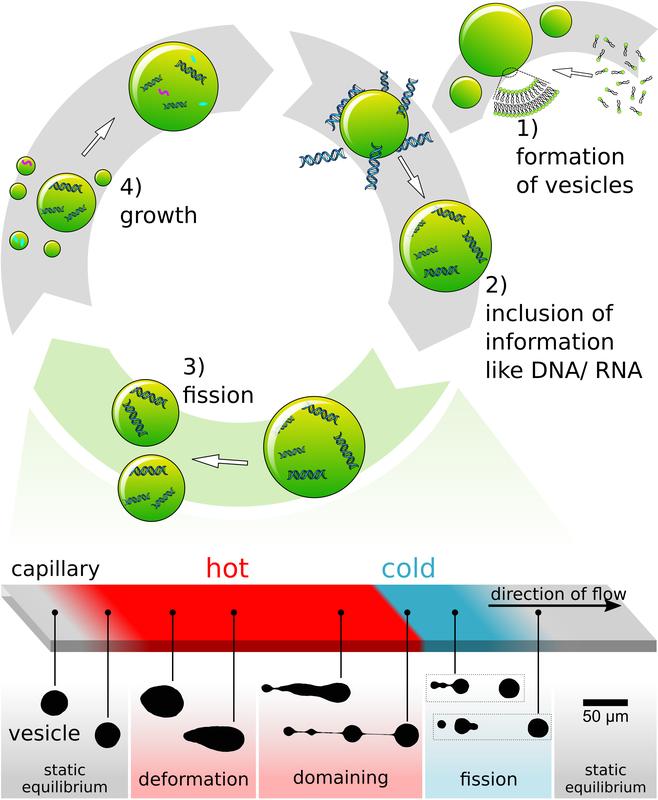Insights into the origin of life: how the first protocells divided

Over time, more and more vesicles that contain various molecules may have formed in a cycle of growth and division. © AG Biophysik, University of Augsburg
If we could travel four billion years back in time, we would find ourselves in a rather inhospitable environment: an atmosphere in which we would suffocate after a few minutes without a respirator mask as the atmosphere only contained a limited amount of oxygen, barren landscapes with-out plants or animals as well as an equally lifeless ocean.
However, the oceans did contain various dissolved molecules. More and more complex compounds must have formed from these until ultimately, hundreds of millions of years later, the first microorganisms emerged. This is at least how most scientists imagine the beginning of life.
A chemical evolution occurred prior to the biological evolution during which the simple starting substances of the “primordial soup” reacted to form more complex molecules. However, this also required suitable “vessels” in which these reactions could occur. Small pellets enveloped by a fat-like membrane and filled with fluid – so-called lipid vesicles – may have performed this function.
“Today we know that such vesicles certainly could have formed at the surface of hot volcanic rocks on the sea floor,” explained Dr. Christoph Westerhausen, head of the biophysics research group at the University of Augsburg. The bubbles tend to integrate further lipid molecules from their environment in the enveloping membrane; i.e. they grow in size while concurrently losing stability.
“The vesicles must divide at some point in order not to burst,” emphasized Westerhausen. “However, it has so far remained unclear how this division process could have occurred.”
Together with the group led by Prof. Dr. Dieter Braun from the Ludwig Maximilian University of Munich, the Augsburg researchers have now suggested a possible mechanism to explain this pro-cess. Volcanic rocks on the sea floor once again play a key role. Upon contact with the primeval ocean, these rocks cool on the outside while remaining hot internally.
Volcanic rock is usually interveined by small channels in which water circulates. The water passes through various temperature zones as it flows. “And, under certain conditions, this effect may result in the division of vesicles contained in the water,” said Westerhausen.
Temperature differences tear protocells apart in a controlled manner
The reason for this is the behaviour of the lipid envelope, which exist in different states depending on temperature: The extremely thin membrane is gel-like at low temperatures. Its building blocks, the lipids, are arranged adjacently and densely compacted. However, the envelope rapidly changes its state if the temperature exceeds a certain value – experts refer to this as a phase transition: The lipids are now suddenly much more agile, but also require a lot more space while the volume of the vesicle does not change.
“A cool vesicle is usually spherical,” explained Christoph Westerhausen. “In this form with mini-mal surface area, it can store the most content.” However, the now suddenly much larger lipid membrane would crinkle during the phase transition. The membrane takes on a new equilibrium form in order to prevent crinkling as the vesicle transitions into an elongated dumbbell form: It now consists of several bulges of comparable size that are respectively connected by a thin lipid channel.
The vesicle suddenly becomes gel-like again if the front part of the dumbbell-shaped structure enters into a cooler environment again. The front bulge contracts and its content must be pressed through the lipid channel into the second bulge, which is still in warm water. The lipid channel may tear due to the resulting tension of the lipid envelope. The resulting holes in the vesicle close again directly: The vesicle splits. “In the laboratory, we use very fine glass tubes for the experimental replication of thin rock pores. These tubes show an increased temperature at a certain location,” said Westerhausen. “We initiate the flow of vesicles through this tube and observe the process with a special microscope. In fact, we were able to observe that the dumbbell-shaped vesicles divided exactly at the point where the temperature change occurred.”
The winsome aspect of the Augsburg-Munich proposal is that it is not based on unrealistic conditions: Volcanic rocks that exhibit an internal temperature gradient are still present at the bottom of the world’s oceans to this day. Perhaps volcanic rocks were once the driving force behind the emergence of life to which we also owe our existence.
Dr. Christoph Westerhausen
Chair for Experimental Physics I and Chair for Physiology
University of Augsburg
Phone: +49 (0) 821 598 – 3311
Email: christoph.westerhausen@physik.uni-augsburg.de
Patrick W. Kudella, Katharina Preißinger, Matthias Morasch, Christina F. Dirscherl, Dieter Braun, Achim Wixforth & Christoph Westerhausen: Fission of Lipid-Vesicles by Membrane phase transi-tions in thermal convection; Scientific Reports; DOI: https://doi.org/10.1038/s41598-019-55110-0
https://doi.org/10.1038/s41598-019-55110-0 Original publication
Media Contact
More Information:
https://www.uni-augsburg.de/de/campusleben/neuigkeiten/2020/02/18/1531/All latest news from the category: Life Sciences and Chemistry
Articles and reports from the Life Sciences and chemistry area deal with applied and basic research into modern biology, chemistry and human medicine.
Valuable information can be found on a range of life sciences fields including bacteriology, biochemistry, bionics, bioinformatics, biophysics, biotechnology, genetics, geobotany, human biology, marine biology, microbiology, molecular biology, cellular biology, zoology, bioinorganic chemistry, microchemistry and environmental chemistry.
Newest articles

First-of-its-kind study uses remote sensing to monitor plastic debris in rivers and lakes
Remote sensing creates a cost-effective solution to monitoring plastic pollution. A first-of-its-kind study from researchers at the University of Minnesota Twin Cities shows how remote sensing can help monitor and…

Laser-based artificial neuron mimics nerve cell functions at lightning speed
With a processing speed a billion times faster than nature, chip-based laser neuron could help advance AI tasks such as pattern recognition and sequence prediction. Researchers have developed a laser-based…

Optimising the processing of plastic waste
Just one look in the yellow bin reveals a colourful jumble of different types of plastic. However, the purer and more uniform plastic waste is, the easier it is to…



